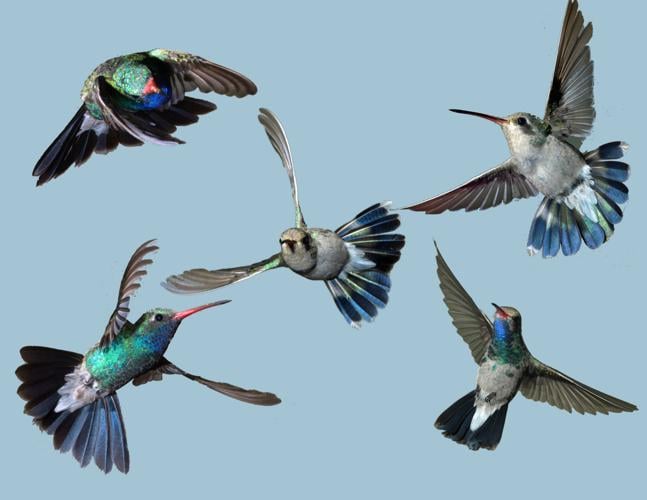Several years ago a young hummingbird that had been blown out of its nest was brought in to the rescue center; as it grew, I wondered how it would learn the intricacies of hummingbird flight. Apparently it was provided with the ability to learn on its own. Because, after a few tentative short flights, it was hovering and doing quite well gathering nectar from Cape Honeysuckle blossoms in the backyard.
Every birder who watches hummingbirds has marveled at their amazingly aerobatic flight abilities. But, just how do hummingbirds fly? These tiny birds have unique flight mechanisms that give them a completely different style of flight than other birds. Understanding that flight can help all birders better appreciate a flying hummingbird.
Most birds are adept fliers with somewhat specialized wing shapes and physical adaptations that work best for their food-gathering lifestyle, whether it is the broad wings of a soaring vulture, the pointed wings of a swift and agile falcon, or the rounded wings of a silently hunting owl.
Hummingbirds, however, have far more unique flight abilities than any other bird and are able to fly not only forward, but also backward, sideways and straight up. They can hover extensively and can do aerobatics such as backward somersaults as they dart among flowers searching for nectar and insects. The unique physical adaptations hummingbirds have are key factors in why they fly so differently from other birds. Not only does their small size allow for better aerial maneuverability, but also other physiological adaptations include:
- Hollow bones, fused vertebrae and fused pelvic bones to eliminate excess muscles and ligaments and to lighten the bird's weight without sacrificing support that protects internal organs.
- Proportionally larger pectoral (chest) muscles and sternum that are responsible for moving the wings. A hummingbird's pectorals account for more than 25 percent of its body weight, a higher percentage than any other bird species.
- Minimal feet to reduce aerodynamic drag in flight. A hummingbird cannot walk; they can only perch or slightly scoot sideways.
- Longer, stronger bones in the "finger" portion of the wing to keep the wing stable with each stroke and to allow greater fine movements to control flight direction.
- Their heart rate can reach as high as 1,260 beats per minute. They have an enlarged heart for more efficient pumping, which supports faster wing beats.
The Mechanics of How Hummingbirds Fly
Just physical adaptations are not enough to give hummingbirds such unique flight abilities. While most birds fly with upstrokes and down strokes, generating all their lift and power on the down stroke of each wing beat, hummingbirds actually stroke their wings forward and backward, pivoting up to 180 degrees at the shoulder to rotate the wing. The wingtip traces a horizontal figure eight in the air with each wing beat that generates lift on both forward and backward strokes, keeping the bird aloft and allowing it to hover. A minute twist can change the angle of the wing and influence the direction of flight, giving the hummingbird the ability to change direction instantly no matter which way the wing is stroking. This type of flight control is more closely associated with insects such as dragonflies than with birds.
Providing perches for hummingbirds can give these birds a place to rest from their exhausting flight, and providing a reliable source of fresh nectar either with hummingbird-friendly flowers or clean hummingbird feeders will give them the energy to sustain their amazing flight.
Sidebar:
Hummingbird Flight Trivia
- Hummingbirds beat their wings from 8-200 times per second.
- A hummingbird can fly up to 60 miles per hour in a steep dive, but speeds of 20-45 miles per hour are more common in straight, steady flight.
- Hummingbirds spend up to 90 percent of their flying time hovering to feed. Because this burns tremendous calories, these birds’ nectivorous diet of sugar water is essential to give them enough energy to fly.





